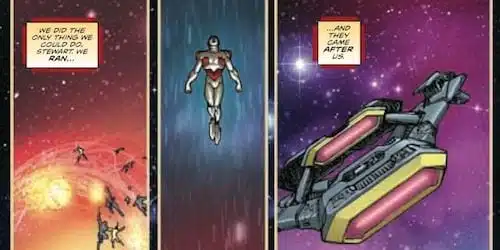
Wheelchair-bound superheroes (I use this term loosely) are nothing new in comicbooks. In fact, there are quite a few of them; the most well-known of them being Professor Charles Xavier of X-Men fame. Barbara Gordon, also known as Oracle, who was famously gunned-down and rendered a paraplegic by the Joker in Alan Moore’s excellent The Killing Joke, is also another favorite. The Chief, otherwise known as Dr. Niles Caulder, the leader of DC’s Doom Patrol, also comes to mind.
With BOOM! Studios’ seventh issue of Stan Lee’s Soldier Zero (the opening issue of “Handling the Truth”) Stewart Trautman and his Hybrid Soldier-Tech Biosyte alter-ego have the potential to reach the same pantheon of fame as their comicbook counterparts but still have some work to do.
“Handling the Truth: Part 1” starts off with the back story of the Soldier Zero hardware, the biosyte, which is itself a living form that has bonded with Trautmann, a handicapped teaching assistant at a university who lost the use of his legs as an American soldier in Afghanistan.
The story, which is told to Trautmann through the memories of the previous Soldier Zero host, an alien named Gorshen, is intended to give the overall story arc more depth, as we actually find out how the biosyte happened upon Earth. The problem lies in how the narrative is told. It’s difficult to make out if Gorshen is in fact, the alien who is reciting the back story and if the back story is the memory that Trautmann is urged to remember. To really figure it out required, for me at least, several read-throughs.
There are a lot of characters and terms that are introduced in the first half of the comic that only make it that much more confusing. It’s too much too soon and, in my opinion, could have been spaced out in more than just the first half of the issue.
The big conceptual hurdle for the book then would be its struggle with continuity. In other words, would the first time reader benefit from having read the first six issues. Sadly, this seems very much to be the case. Earlier issues do not so much offer a more coherent storyline, as they provide a clearer posing of the questions being answered in this issue. What has built up then, is a detailed framework which poses crucial questions about the back story of Soldier Zero. Some of these questions are answered this issue. But ultimately though, despite the “long-haul” style of creativity, Soldier Zero is a title worth getting up to speed on.
Once, however, the story picks up from the last issue and we learn more about the mysterious Application Nine, it’s smoother sailing from there and the action picks up as well as the storyline.
In the beginning of the story, Gorshen tells Trautmann to do two things. First, he must not forget the memory that is being told to him and secondly, he must be ready to take control of the biosyte or it will take control of him.
This, of course, is a metaphor for Trautmann’s attitude toward his disability, and, for that matter, what many people with disabilities go through: the struggle to not only cope with one’s handicap, but to strive to overcome it. It’s a message that is not so subtle, and at times, somewhat preachy, but with good intentions. Of course, Trautmann’s struggle to bond with his biosyte also speaks to technology and the bond we as humans have with it, constantly struggling to find a balance in our own lives.
Unlike Charles Xavier, Oracle or The Chief, Stewart Trautmann’s wheelchair is only a part-time gig. The Soldier Zero suit provides him with temporary relief from his paralysis, enabling him to perform extraordinary feats. A similar scenario comes to mind with one of Stan Lee’s other comicbook creations, The Hulk. Like his newly-created counterpart, Bruce Banner is on a never-ending struggle to find balance between his human side and the creature that’s become a part of him.
Like The Hulk, the humans in Soldier Zero #7 think that the alien biosyte is a monster out to attack them. It’s up to Stewart Trautmann to embrace and overcome his limits and find the balance between his monster and the hero he’s meant to be.
